Tavsali or Goan Cucumber Cake recipe with step-by-step photos and instructions.
Learn how to make cucumber cake without eggs. Failproof recipe with the correct ratio of ingredients. East Indian cucumber cake recipe that is simple and easy to prepare.
Tavsali is a traditional Goan cake recipe using cucumbers that can be served as breakfast, evening snack, or sweet post-lunch. It is not truly a cake since it does not use eggs, maida (refined flour) or baking powder.
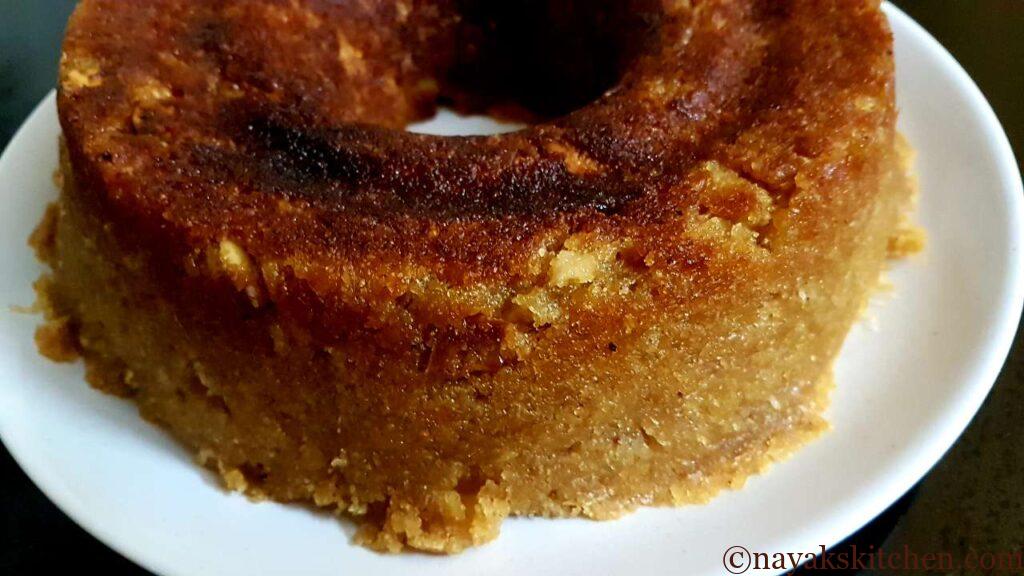
Tavsali is made using a special, local, seasonal cucumber available during the monsoons along the Konkan belt, Goa, Karwar etc. This cucumber is called ‘Tavshe’ in Konkani and is different from the usual vegetable cucumbers available. However, you can prepare this cake using regular cucumbers too. The taste will vary though. (More in detail about the ‘Tavshe’ later in the post).
I just love this traditional Goan cake recipe and I’m always on the lookout for these ‘Tavshi’ (plural of Tavshe) during monsoons. This is a very unique cucumber sweet dish. Tavsali is a very moist, aromatic and healthy cake. You can steam or bake this cake too.
A very easy cucumber recipe, this is one of the simple cucumber recipes you will just love.
Similar to the Tavsali is the Goan jackfruit cake known as ‘Dhonas‘ or ‘Pansachi Bhakri‘. It is made using jackfruit pulp, rava (semolina), jaggery, grated coconut and ghee. Do check out the recipe below.
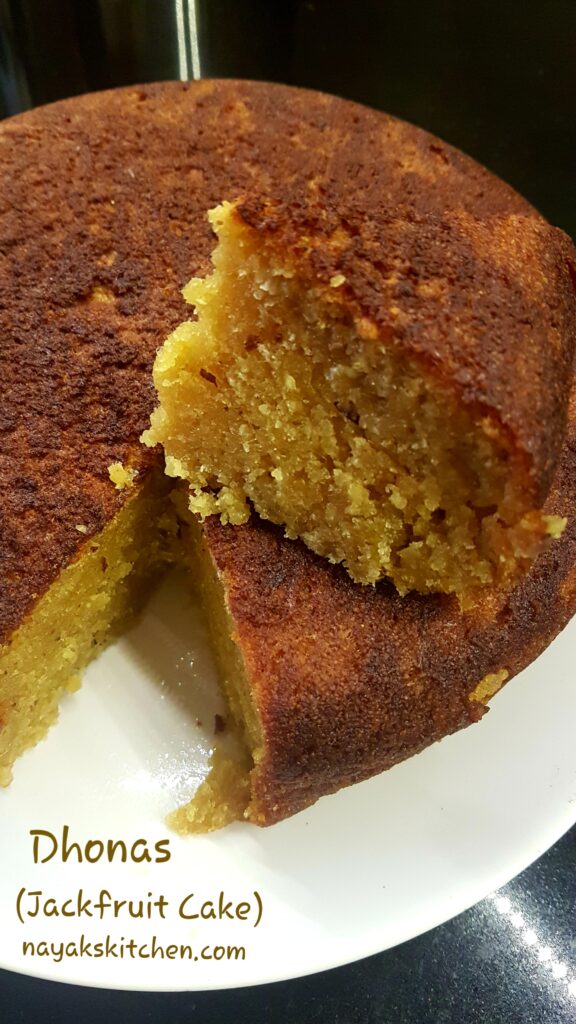
What is Tavsali?
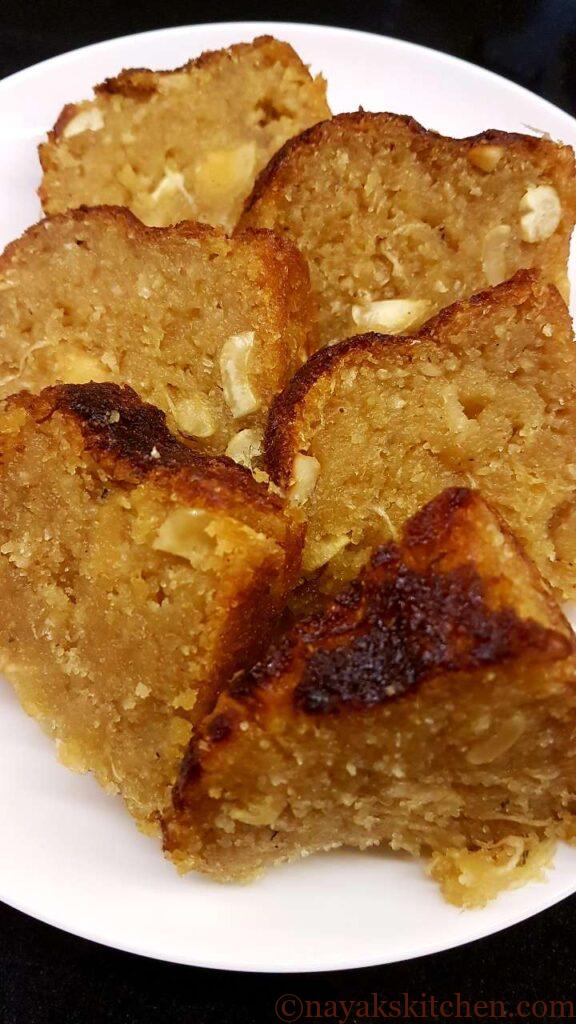
Tavsali is a kind of cake, prepared using Tavshe (local seasonal cucumber), rava (sooji or semolina), jaggery and coconut. This cake can be baked or steamed.
I prefer baking this cake rather than steaming it as its crust turns out very crisp. This is a vegetarian cake yet very flavourful and aromatic.
Tavshe – The giant cucumber
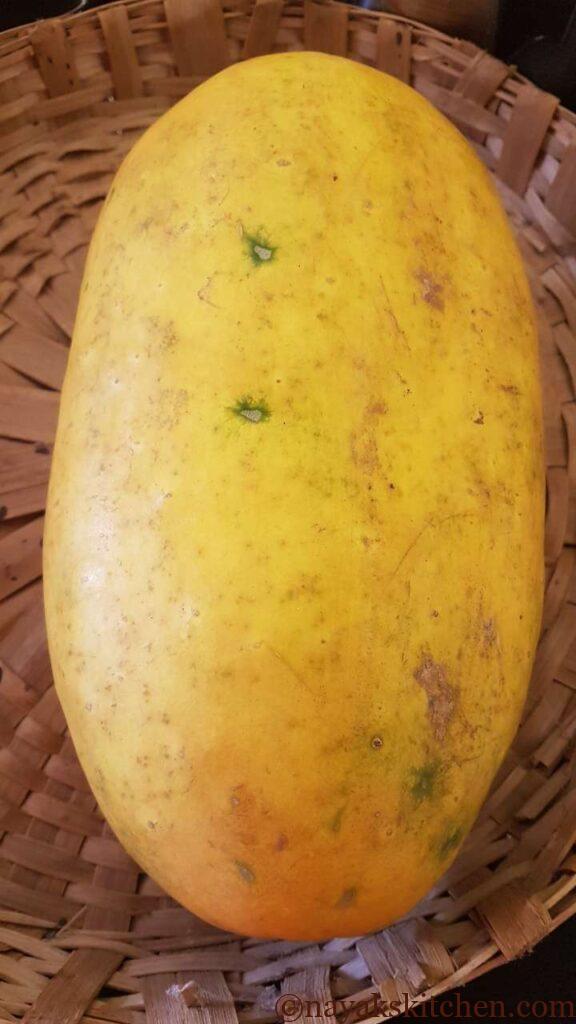
During the monsoons, you will find the local markets selling large-size cucumbers. These cucumbers are available from August to October. They are giant-size and have a lot of water content in them. That is what makes the Tavsali soft, moist and gives it a melt-in-the-mouth texture.
Also, these giant cucumbers have a refreshing flavour that is alluring. These cucumbers are exclusively used to make this flavoursome cucumber cake or ‘Kakdichi Tavsali‘ (The small vegetable green cucumbers are called Kakdi in Konkani and Marathi).
They are yellow in colour, unlike the vegetable green cucumbers. Also, they are huge compared to the latter. Check out the pic below to see the difference. Sometimes they are even bigger than the one shown below.
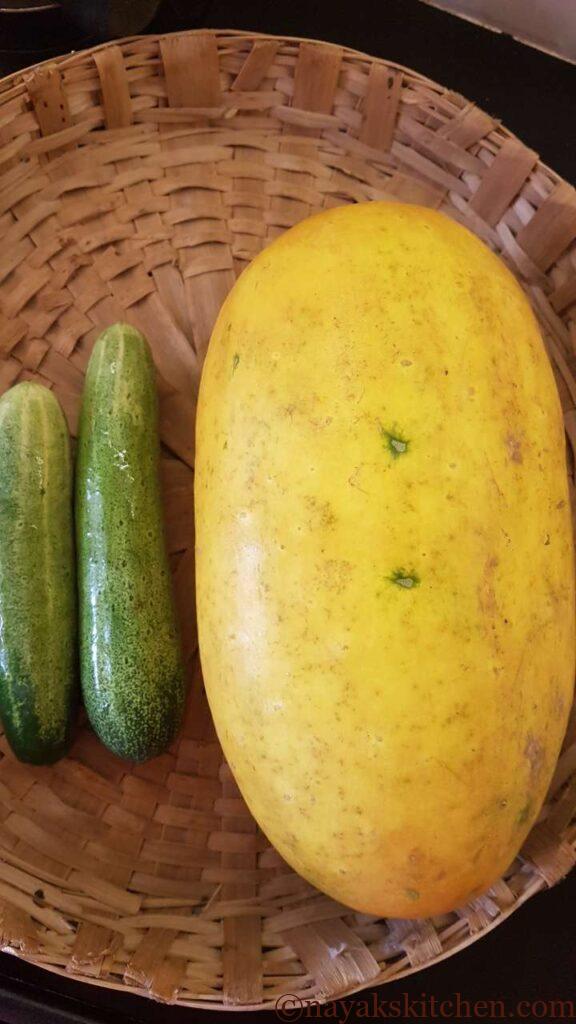
Since these Tavshi are seasonal (or you may also not find them in your area) you can always make this recipe using regular vegetable green cucumbers. But local Tavshi have a flavour unique to it. So do try this tavsali recipe with Tavshe when in season.
Methods to cook Tavsali
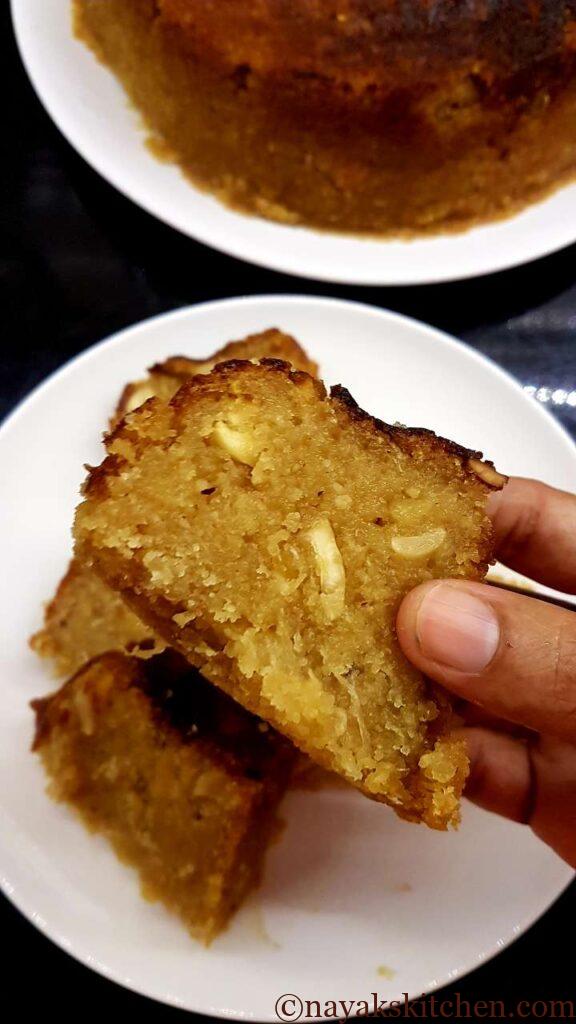
So how can you cook the Tavsali? There are 4 ways to do it.
- Steaming
- Baking in a pressure cooker
- Baking in an oven
- Baking in a traditional Cake Pot/Pan
a) Steaming
You can steam this cake in a steamer, idli cooker or pressure cooker. Grease a steel container, spread the cake batter evenly. Add water to the base of the steamer or pressure cooker. Place a stand/trivet inside. Keep the steel container on the trivet. Remove the whistle/weight if using a pressure cooker. Steam for 30-45 mins.
b) Baking in a pressure cooker
To bake in a pressure cooker, grease the pressure cooker with ghee. Spread the cake mixture evenly and place it on the gas. Cook on a medium flame for 30-45 mins or until done. (A knife inserted should come clean). Note: Remove the whistle/weight and cook.
Sometimes I prefer to cook the Tavsali using this method.
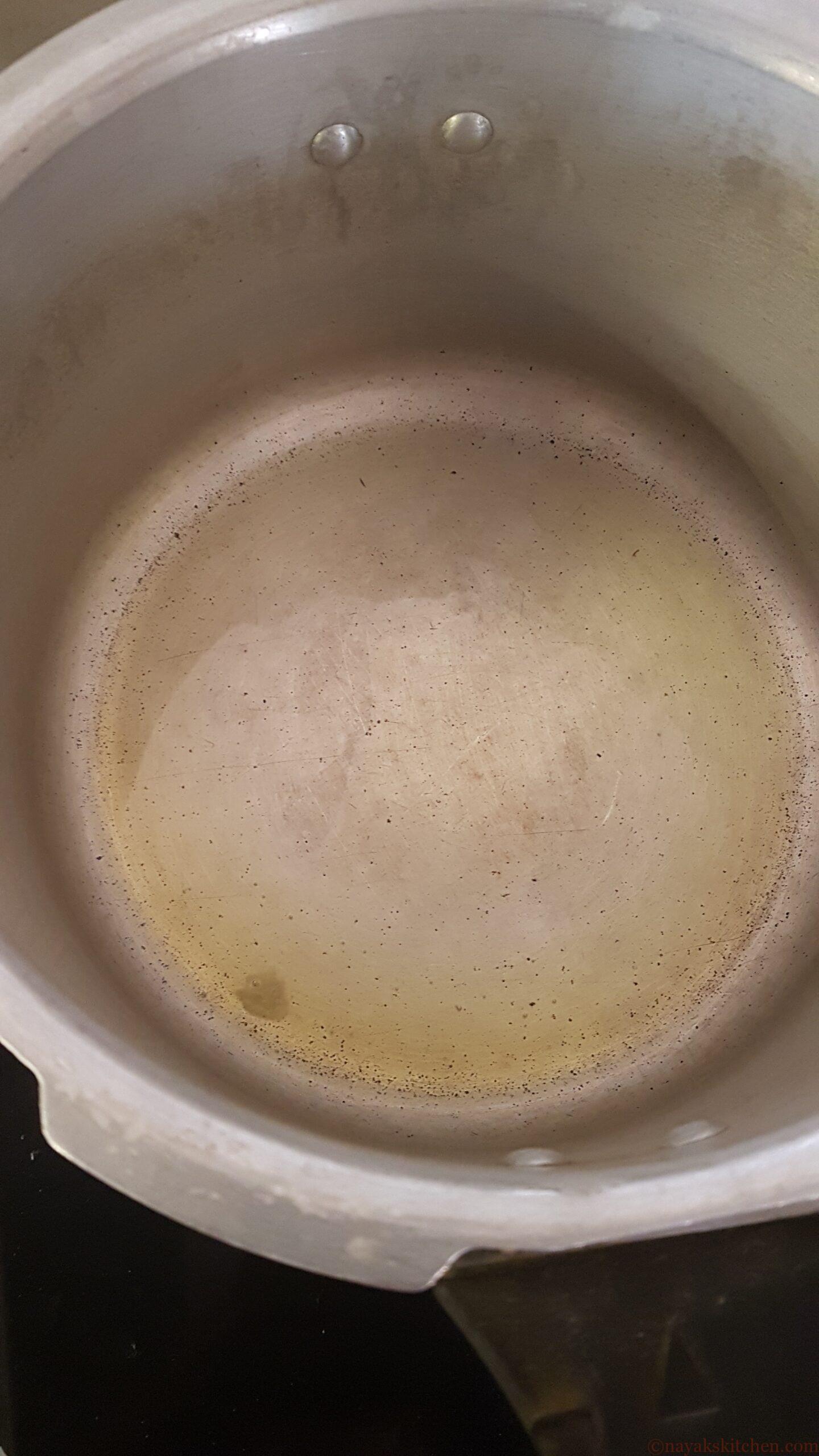
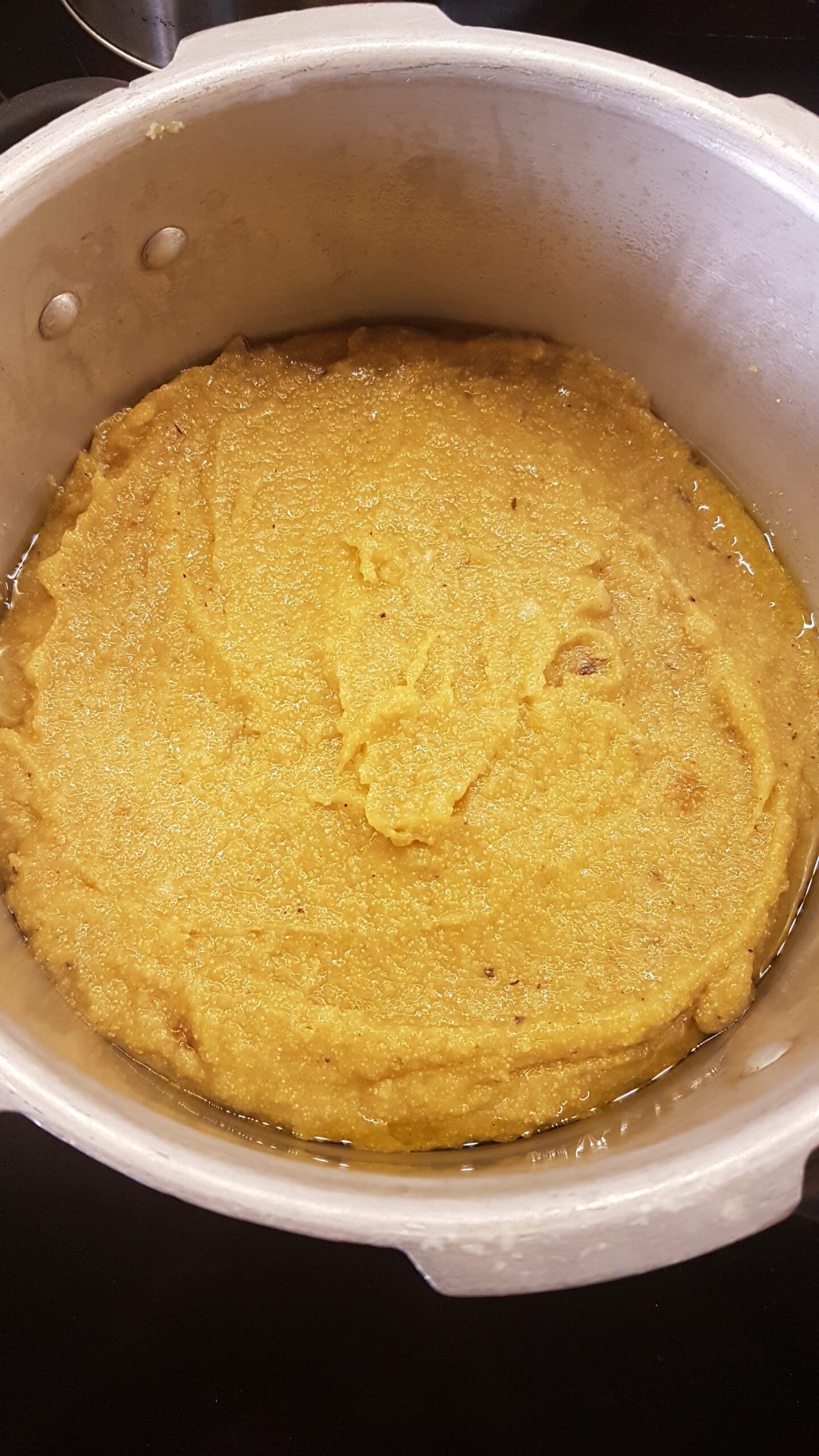
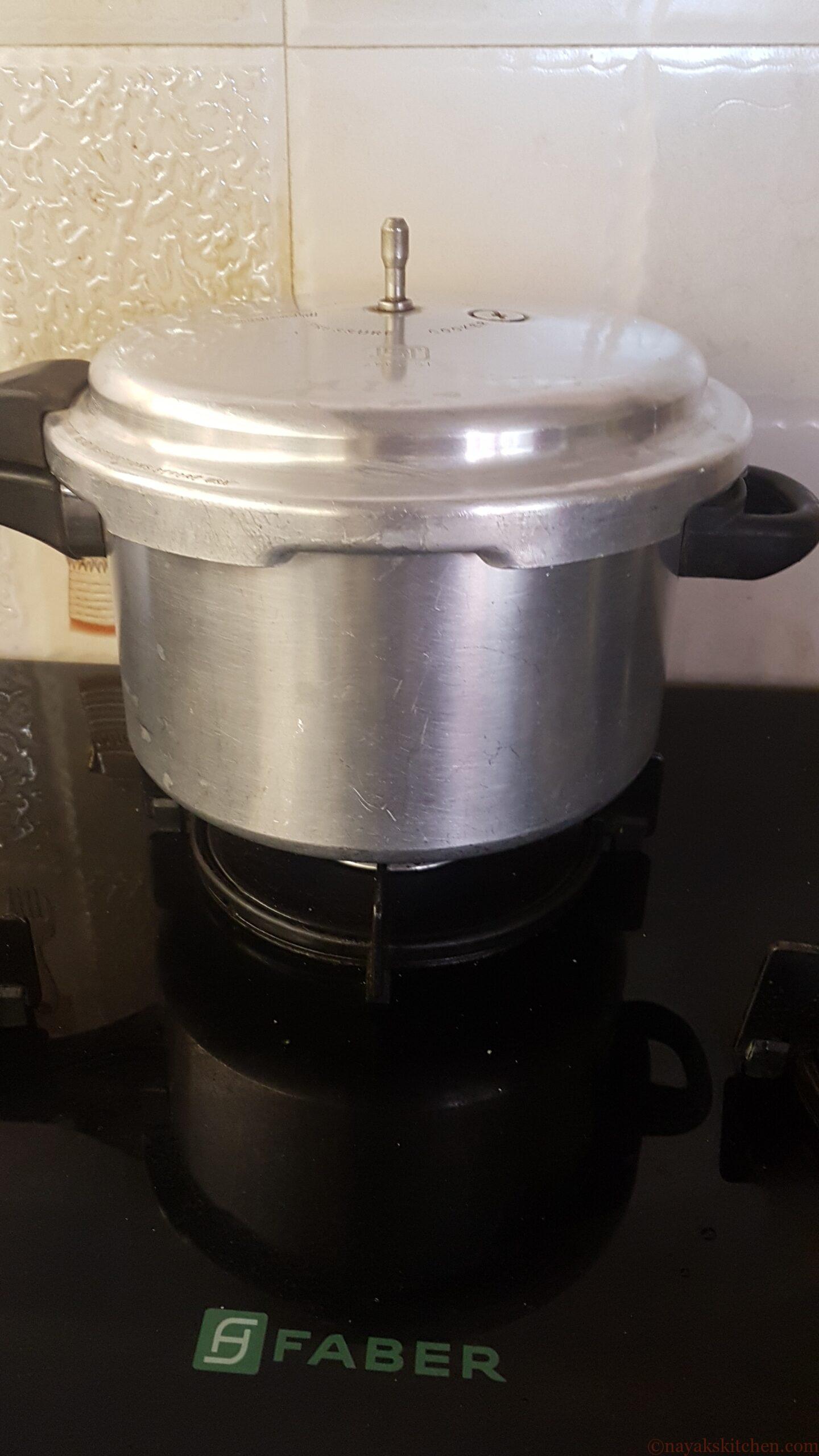
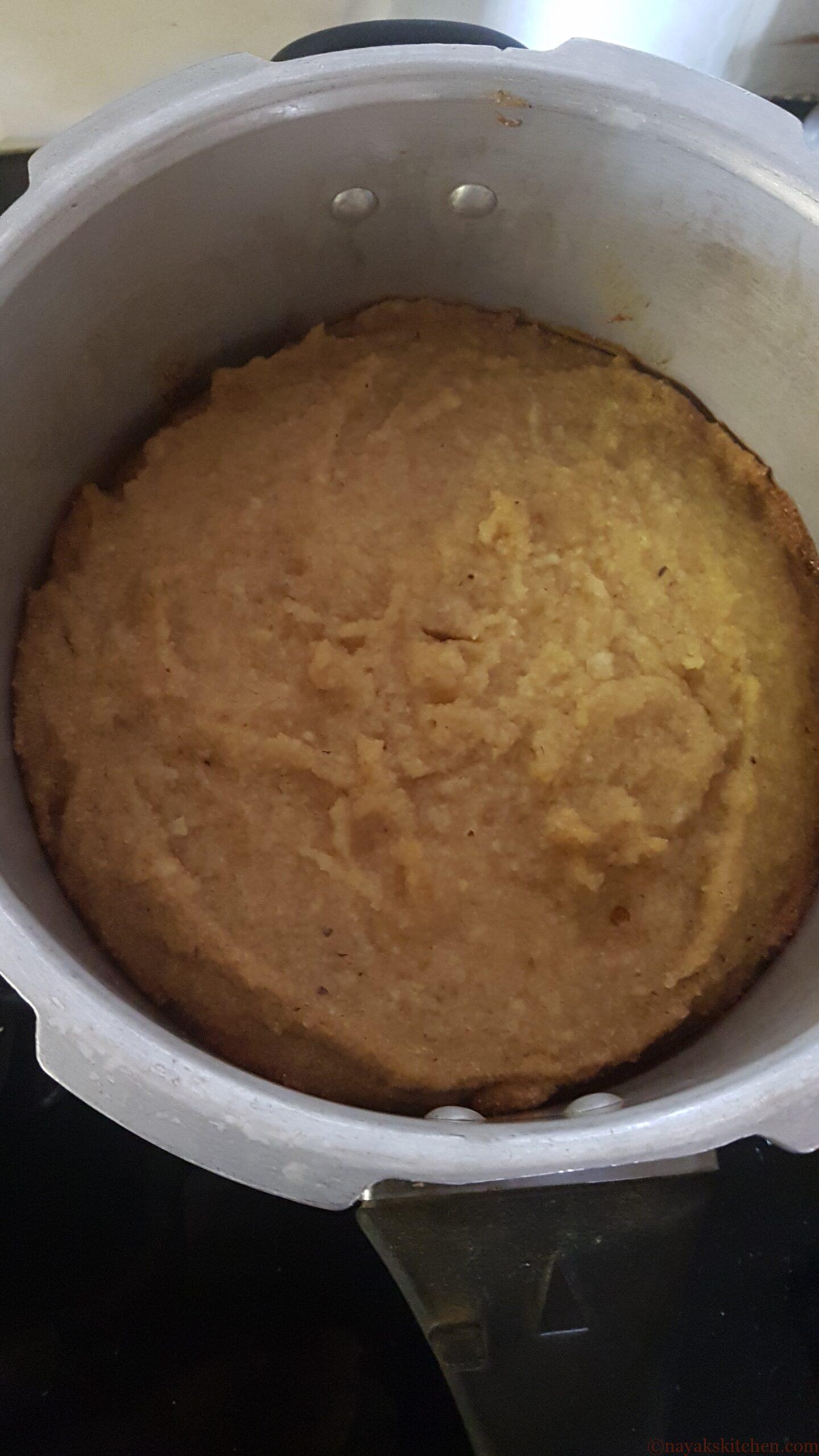
c) Baking in an oven
You can bake this cake in an oven for 40-45 mins at 200 degrees Celsius. (Note: Baking time may slightly vary with different ovens). However, baking in the oven yields a bit of dry cake.
d) Baking in a traditional Cake pot (Handvo Pot)
I love to cook Tavsali in a traditional cake pot. (pic below). This cake pot (also called the ‘Handvo pot’; Gujaratis use it to cook Handvo*) gives a perfect cake. Crisp and golden on the outside and soft and moist on the inside. It is similar in shape to the ‘Bundt pan‘ used in baking.
*Handvo is a mixed lentil vegetable cake

Zoom in and see the beautiful Tavsali texture below.
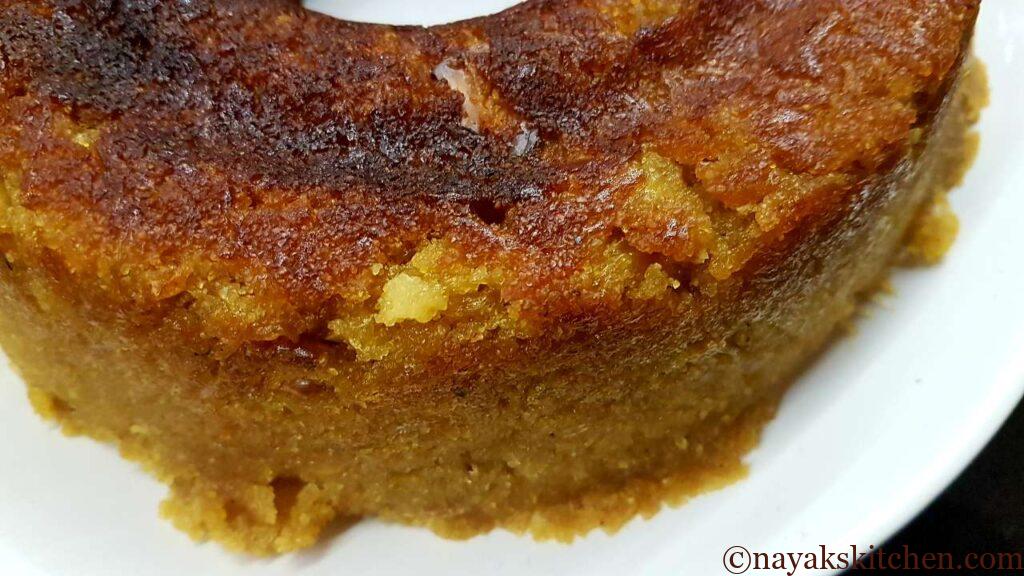
This pot evenly cooks the cake inside-out due to the presence of the round hole in the centre. The crust of the cake turns nice golden brown and gets a beautiful crumbly texture too.
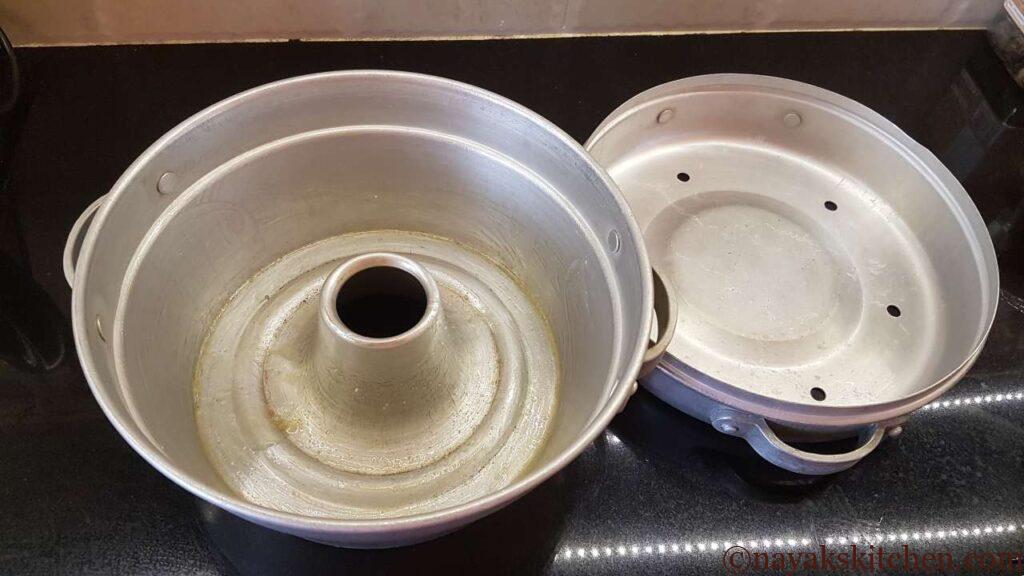
It has a plate that has to be placed directly on the flame (see pic below). The plate should be filled with either salt or sand as they both retain heat and aid in faster cooking. The pot is then placed over the plate.

Tips
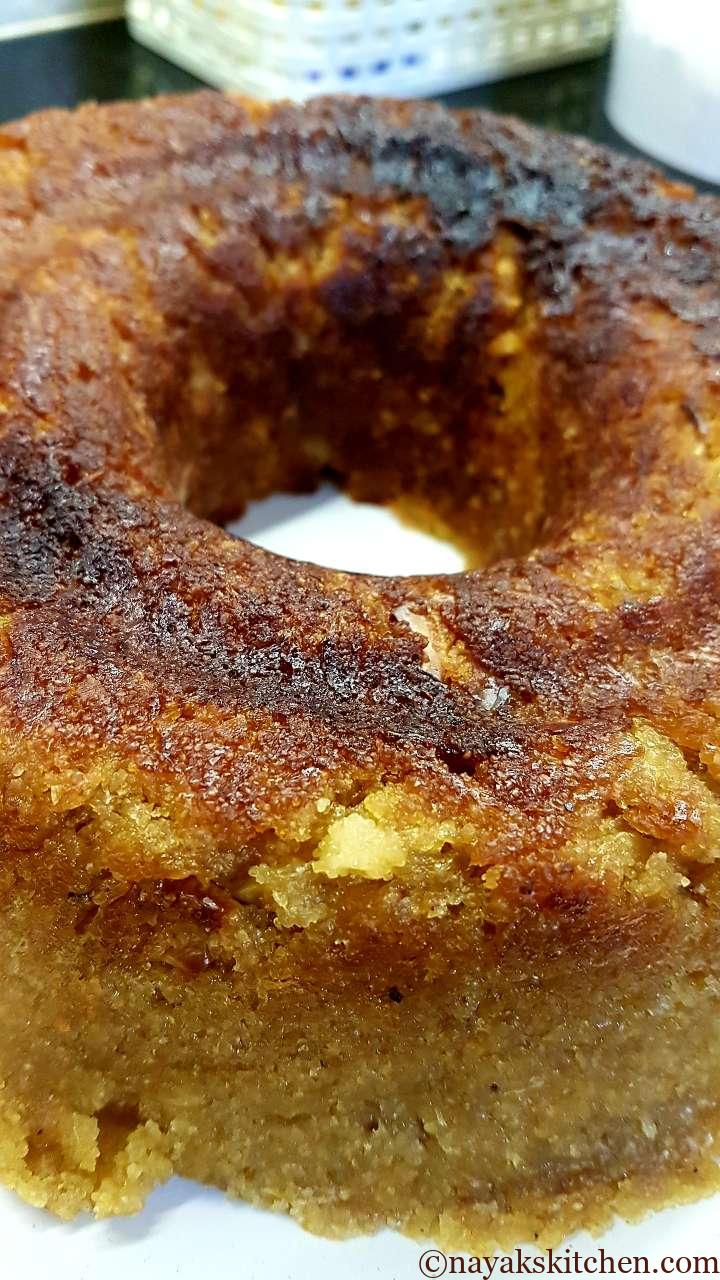
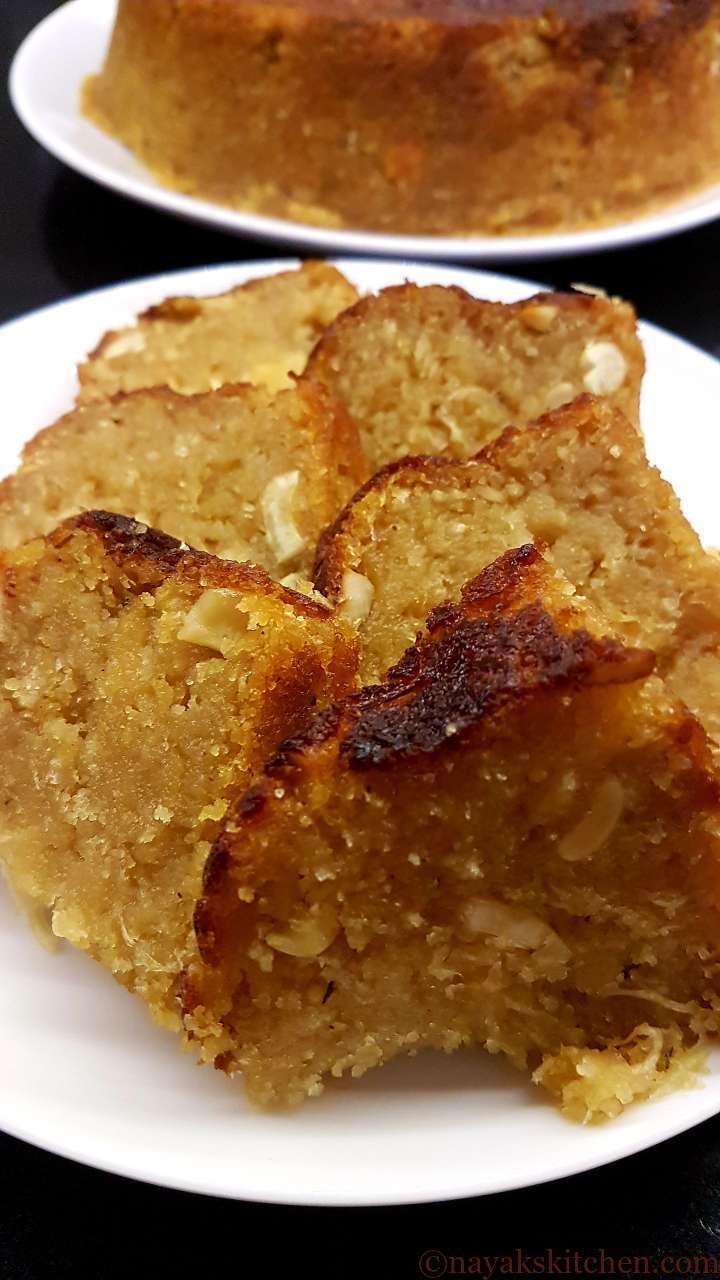
- The seeds of the Tavshe are very firm and hard. Hence, they must be removed. However, if you are using green vegetable cucumbers you can use them along with the seeds if they are very tender.
- When you grate the cucumber it will release a lot of water. Do not throw the water. It has to be used in the recipe. Else your cake will turn out dry.
- Roast the rava well till it releases an aroma and changes to light brown.
- The final batter of Tavsali is thicker as compared to regular cake batters. So do not add water.
- Using turmeric leaves is optional. But it renders a soulful aroma to the tavsali.
- Also, keep checking the cake in between. The sides will turn light brown once done.
- Do not demould when hot. The cake will disintegrate. Allow it to cool completely.
- You can store Tavsali in the fridge for about a week. To reheat, heat a tava/pan and drizzle with a little ghee. Place the pieces on the tava/pan and heat on a very low flame. Turn and fry all sides till golden brown. It tastes really awesome.
- This recipe can be doubled or halved also.
How to make Cucumber Cake (Tavsali)?
- Heat ghee in a kadhai (pan). Roast rava (semolina) until it turns light brown and releases an aroma. Allow it to cool.
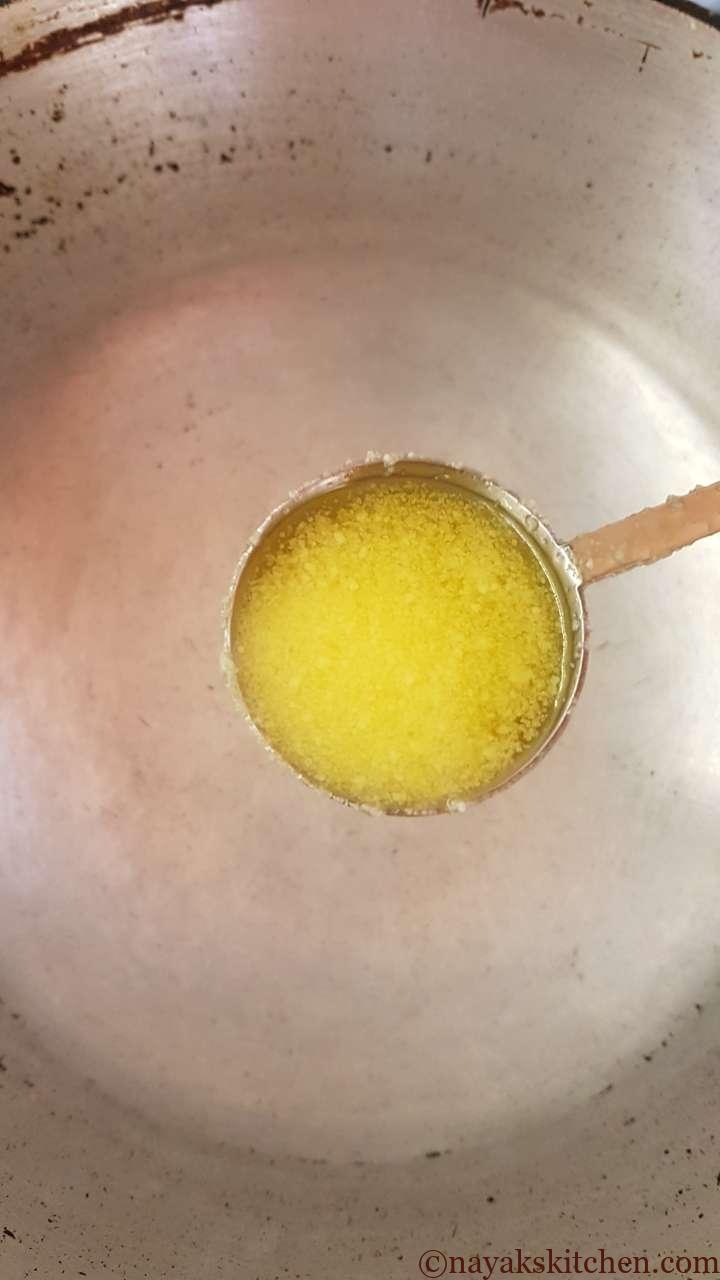
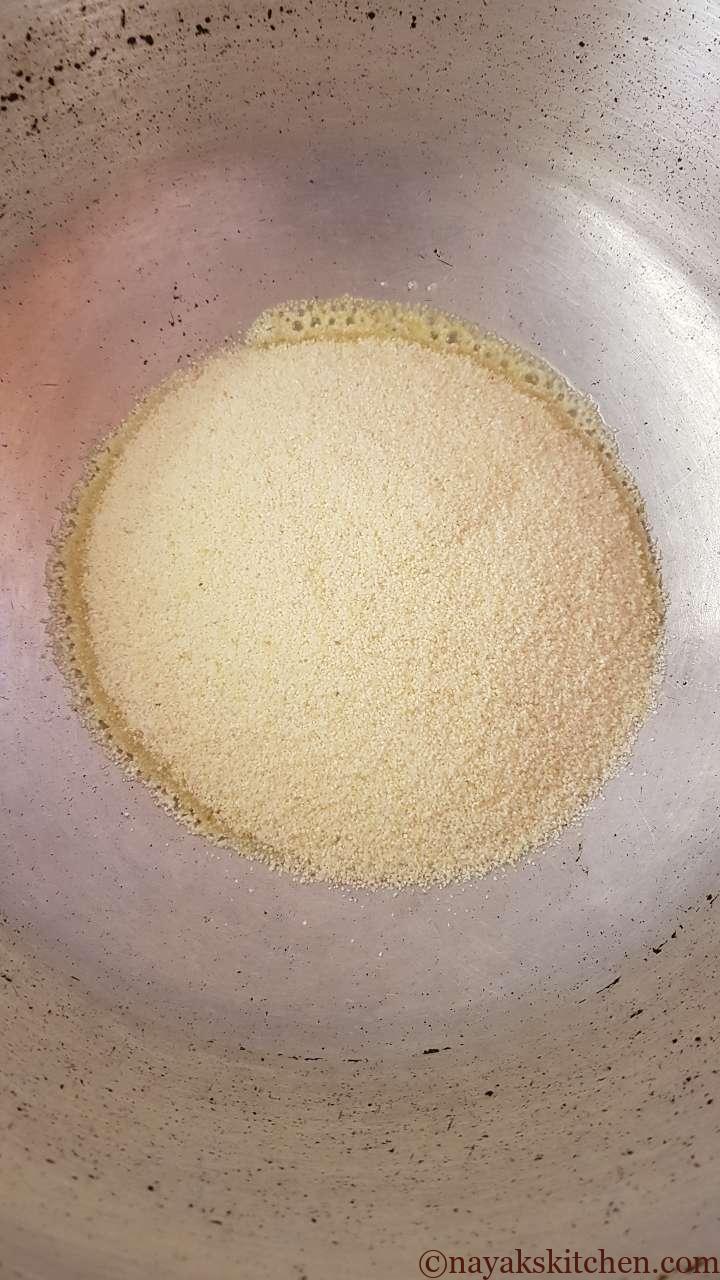
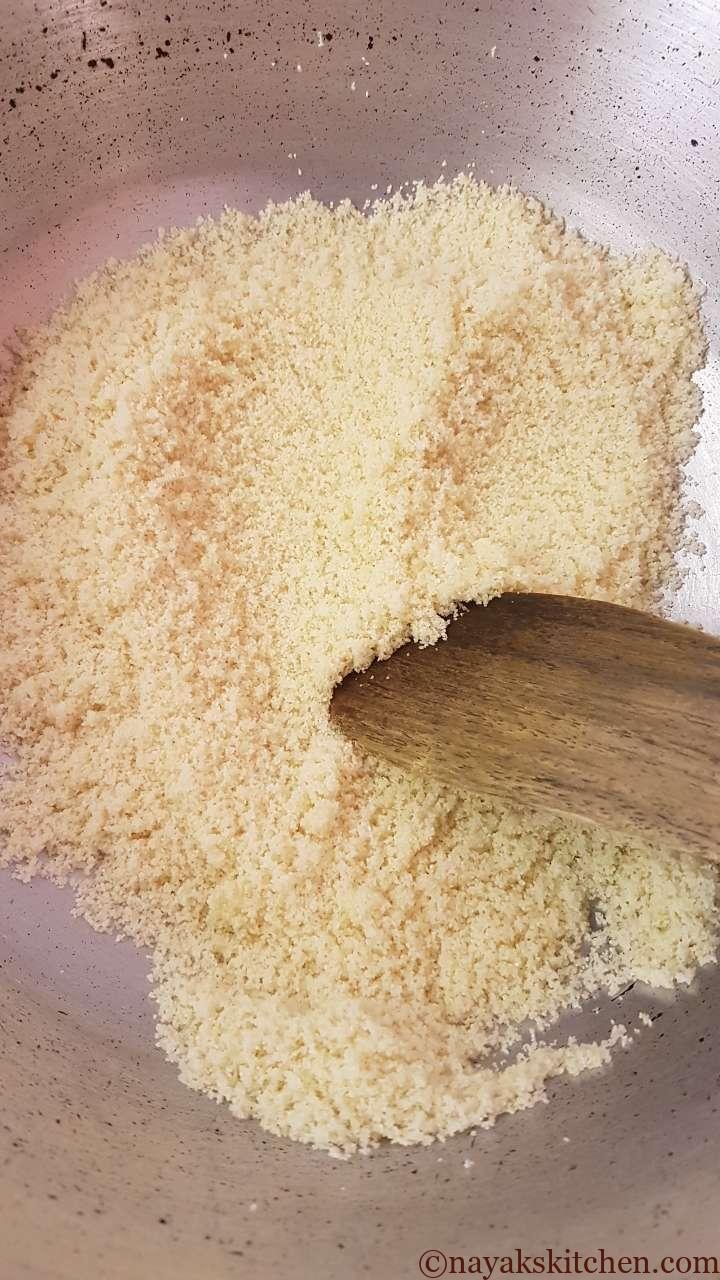
2. Take the Tavshe and peel it.
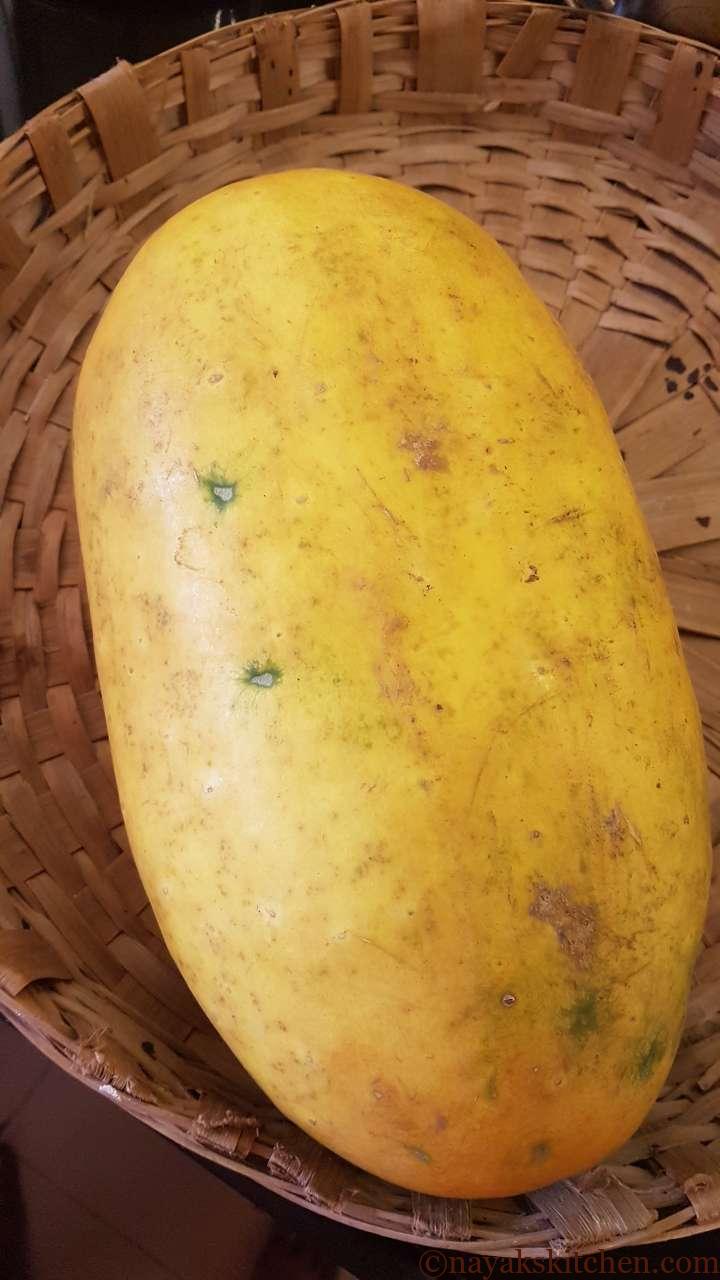
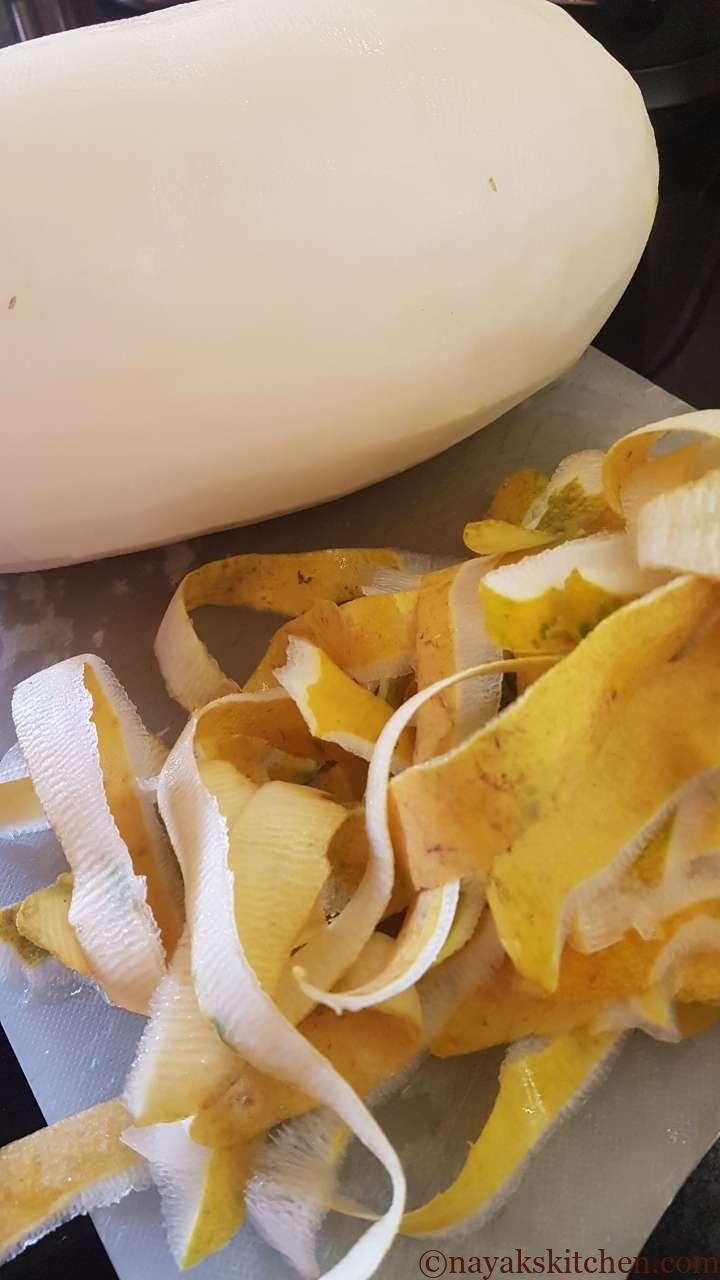
3. Cut the Tavshe into halves. Then, cut into quarters.


4. To remove the seeds, make a slit on its thin skin. Remove the seeds.
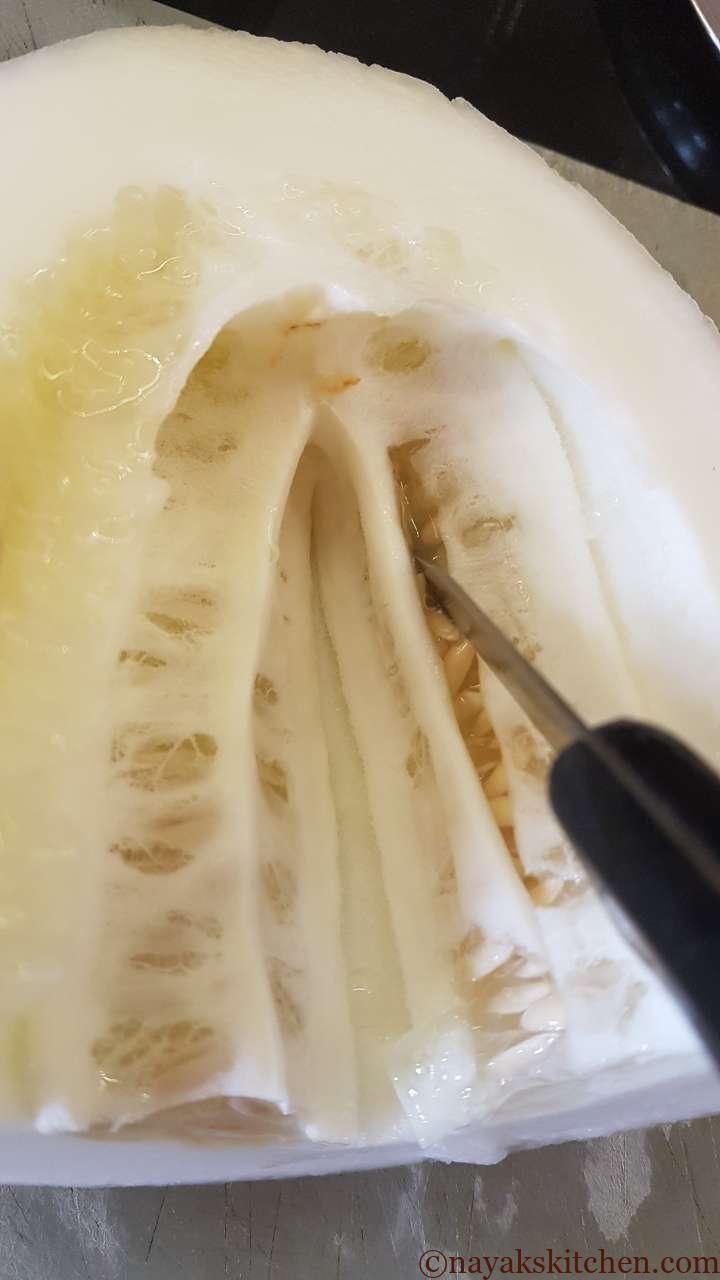

5. Remove as many seeds as possible since they are very hard. Wash and dry the seeds. You can germinate them to grow tavshi.

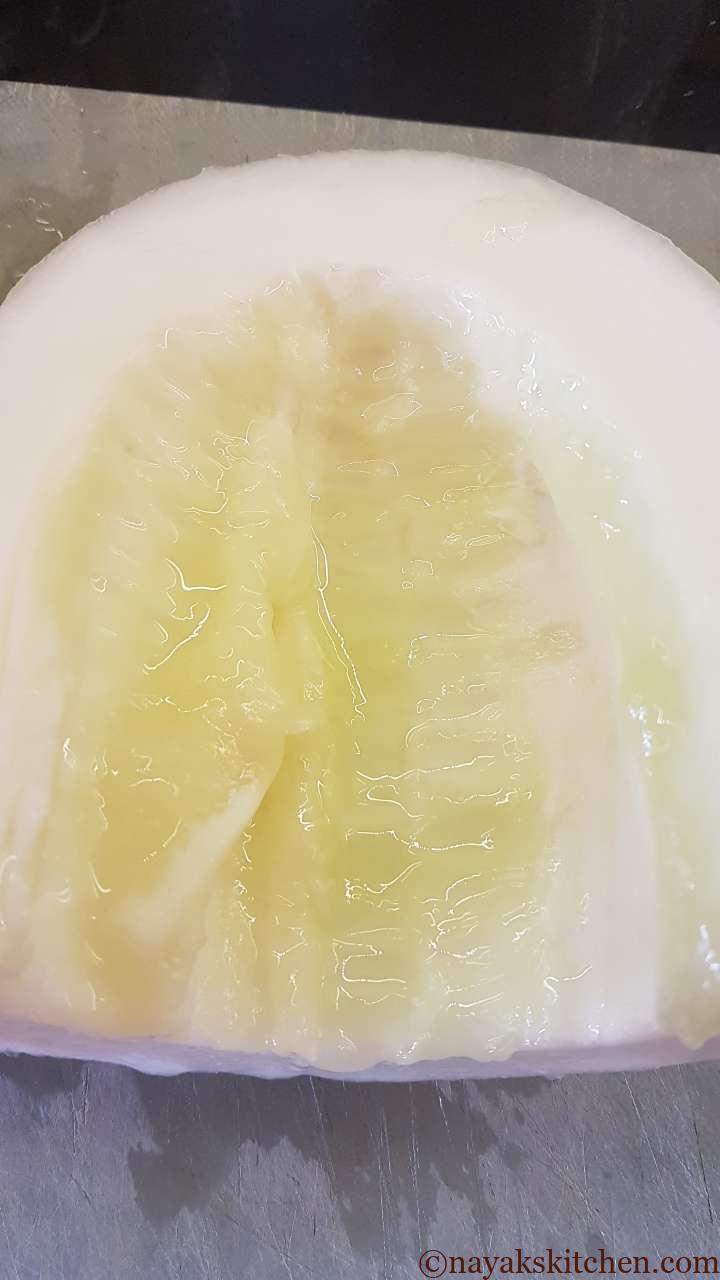
6. Grate the cucumber. Also, do not throw out its water. Next, add jaggery and grated coconut to the grated cucumber along with its water.
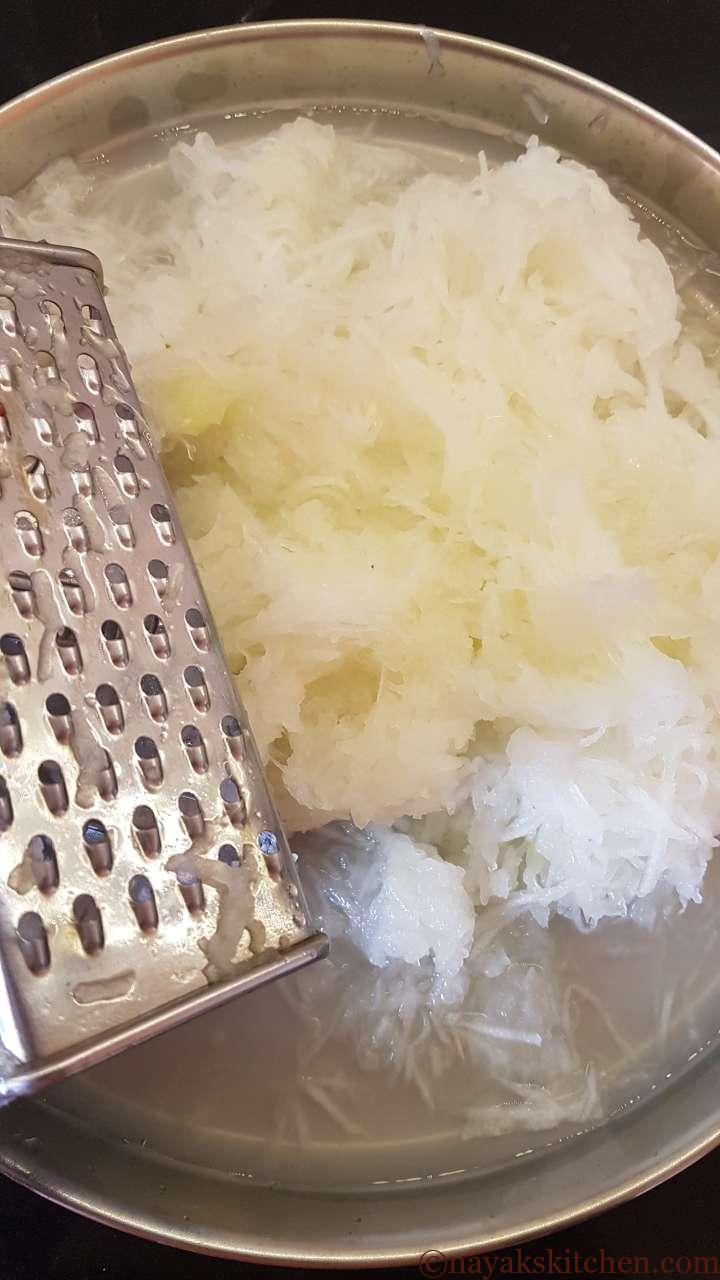

7. Further, add salt and mix everything well.


8. Add pieces of cashew nuts. Now take this mixture in a deep-bottomed pan or kadhai. On medium flame, allow the jaggery to melt.
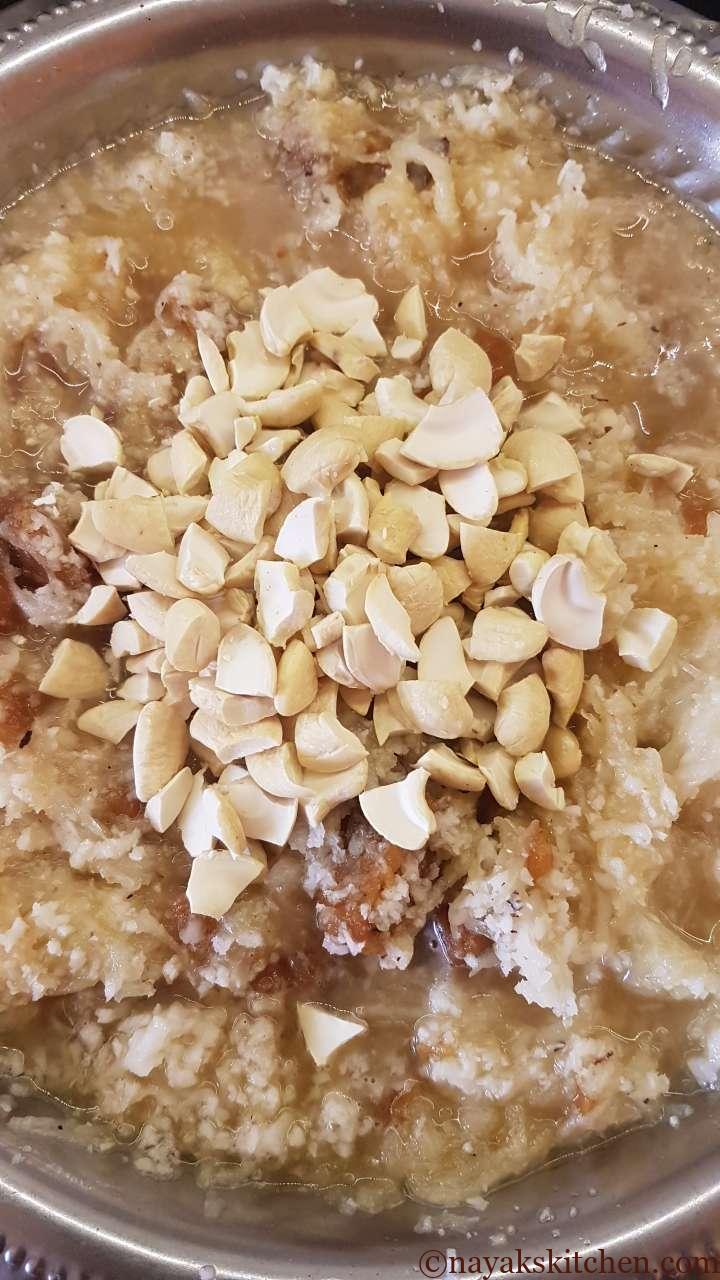
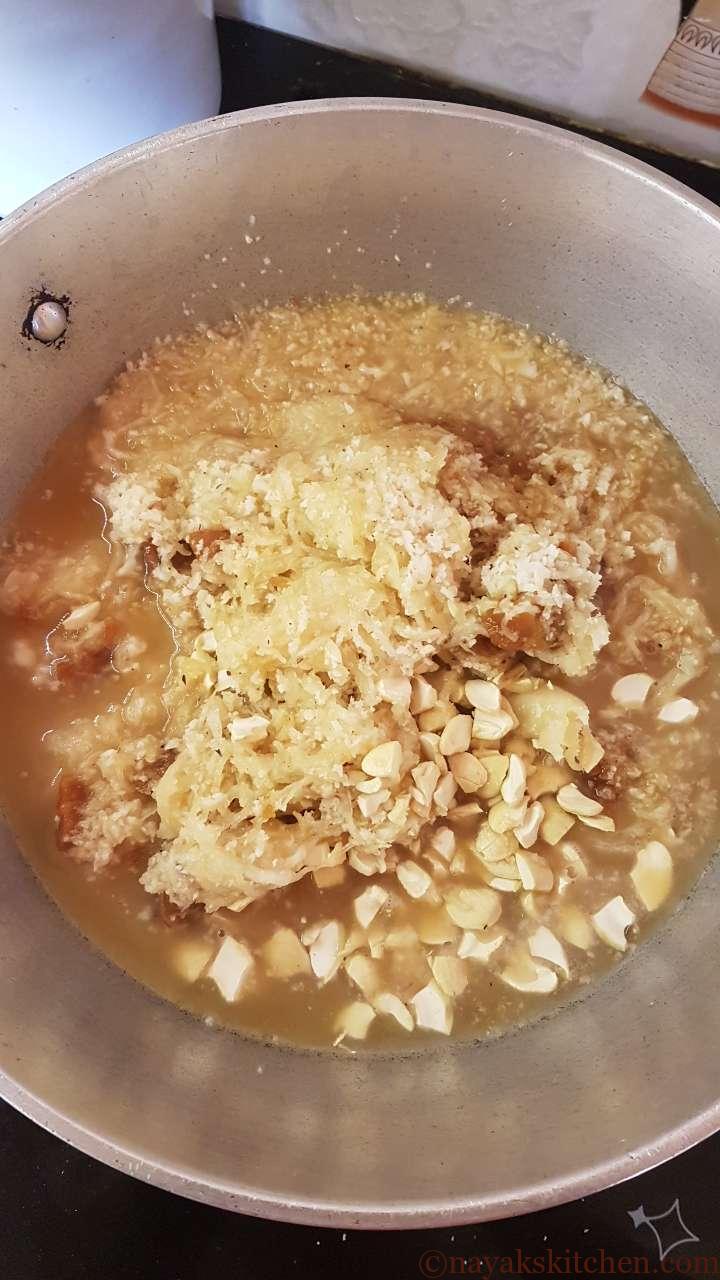
9. Once the jaggery melts completely, finally add the roasted rava (semolina).

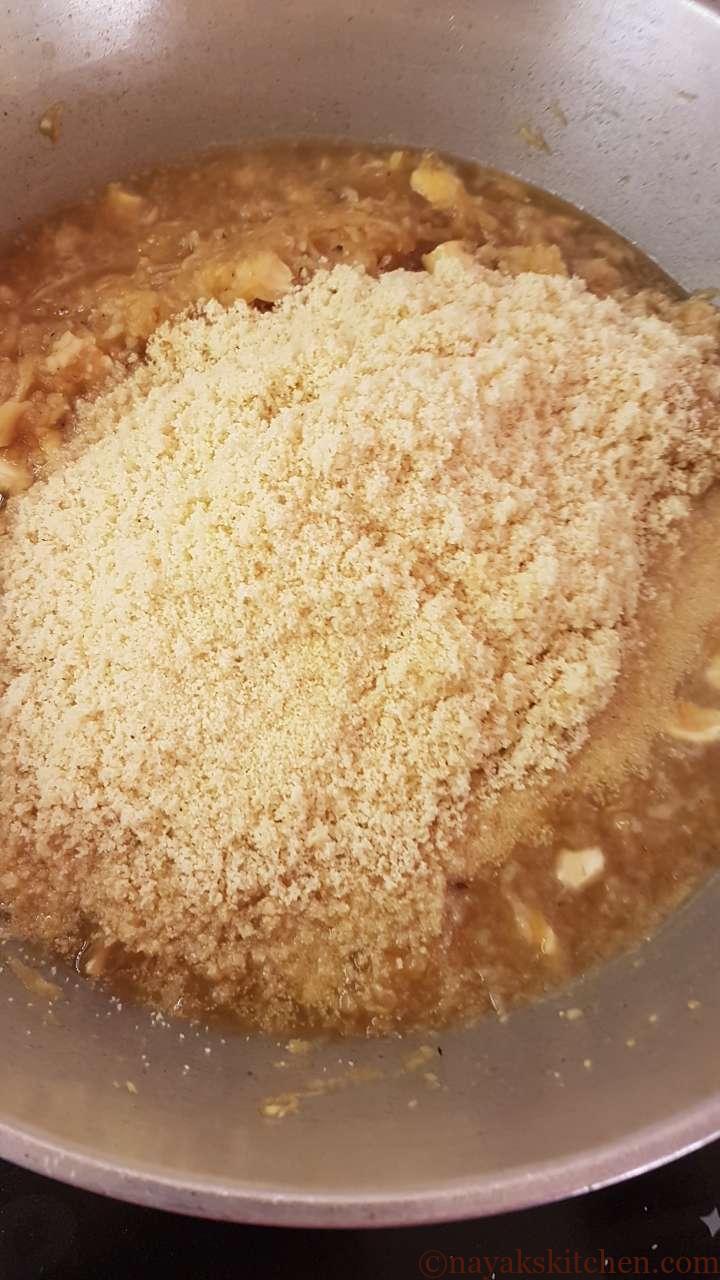
10. Keep cooking further till the rava absorbs the water in the mixture. Once this mixture dries up switch off the gas. Also, grease the cake pot or pressure cooker with ghee. (You can also steam or bake in an oven. Refer ‘Methods to cook Tavsali‘ section above for more details.)
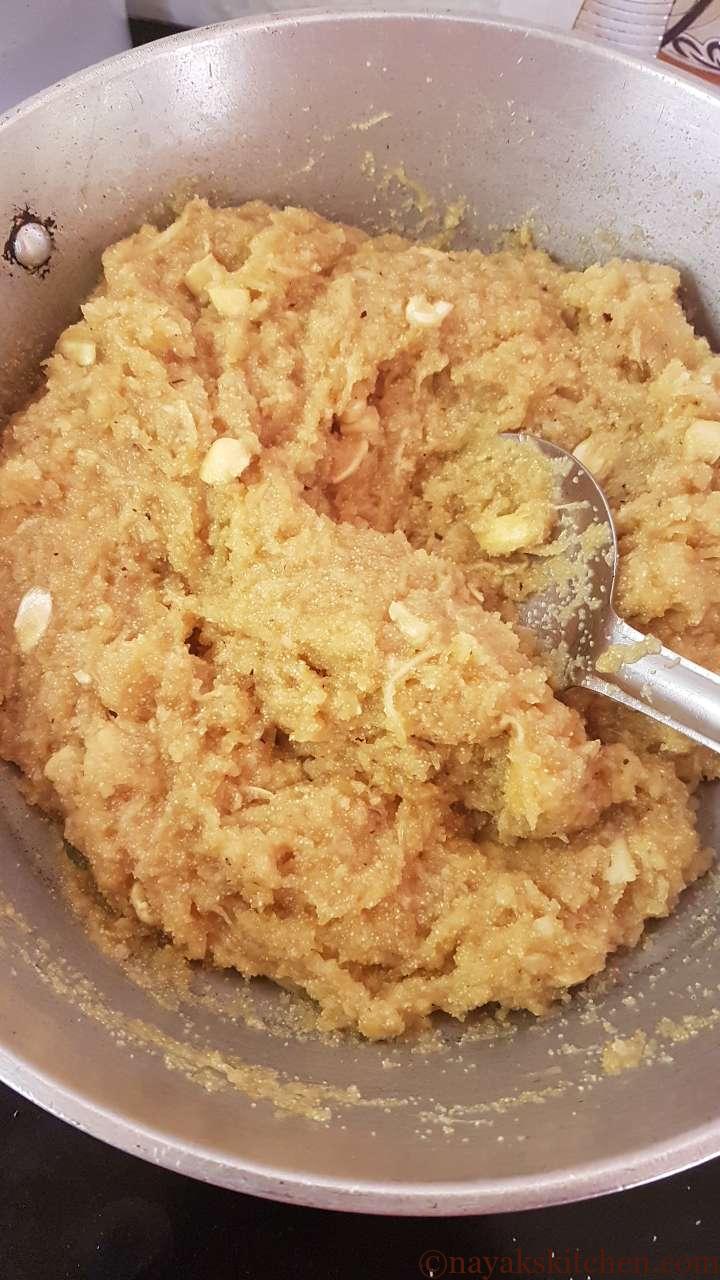

Cooking Tavsali
11. Next, transfer the cake mixture to the pot. Apply ghee to a small steel bowl (vati).
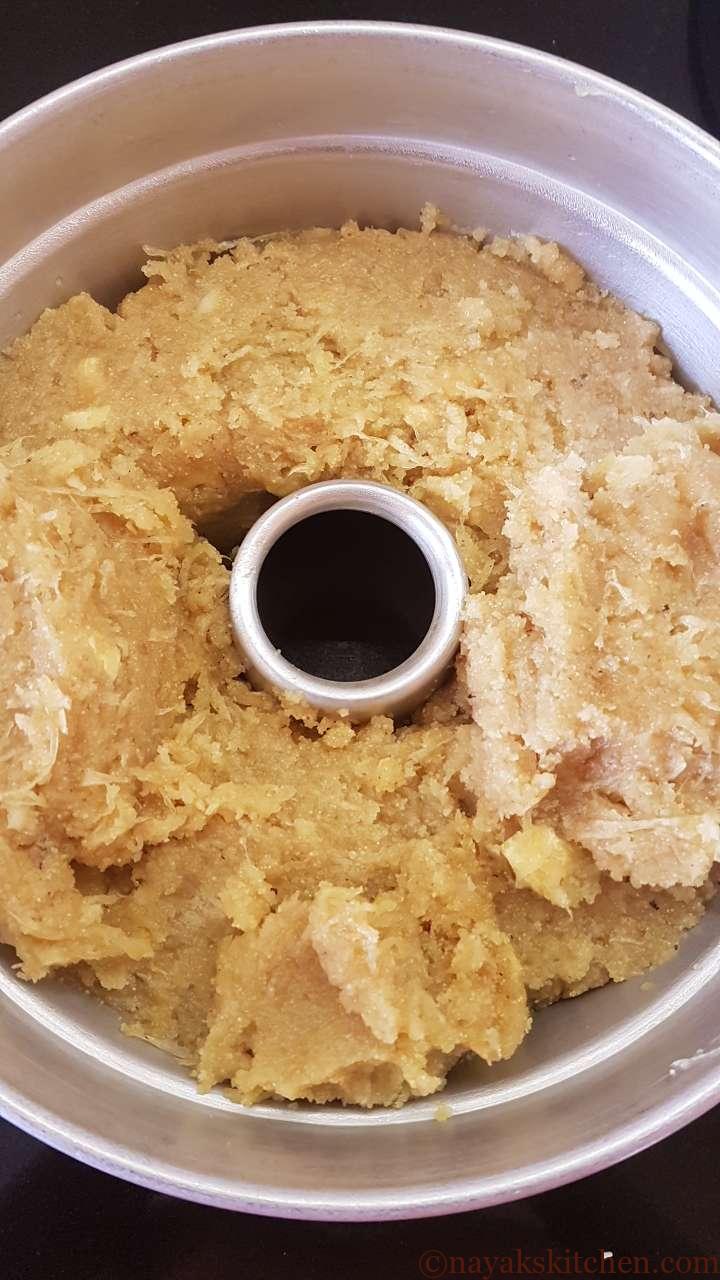
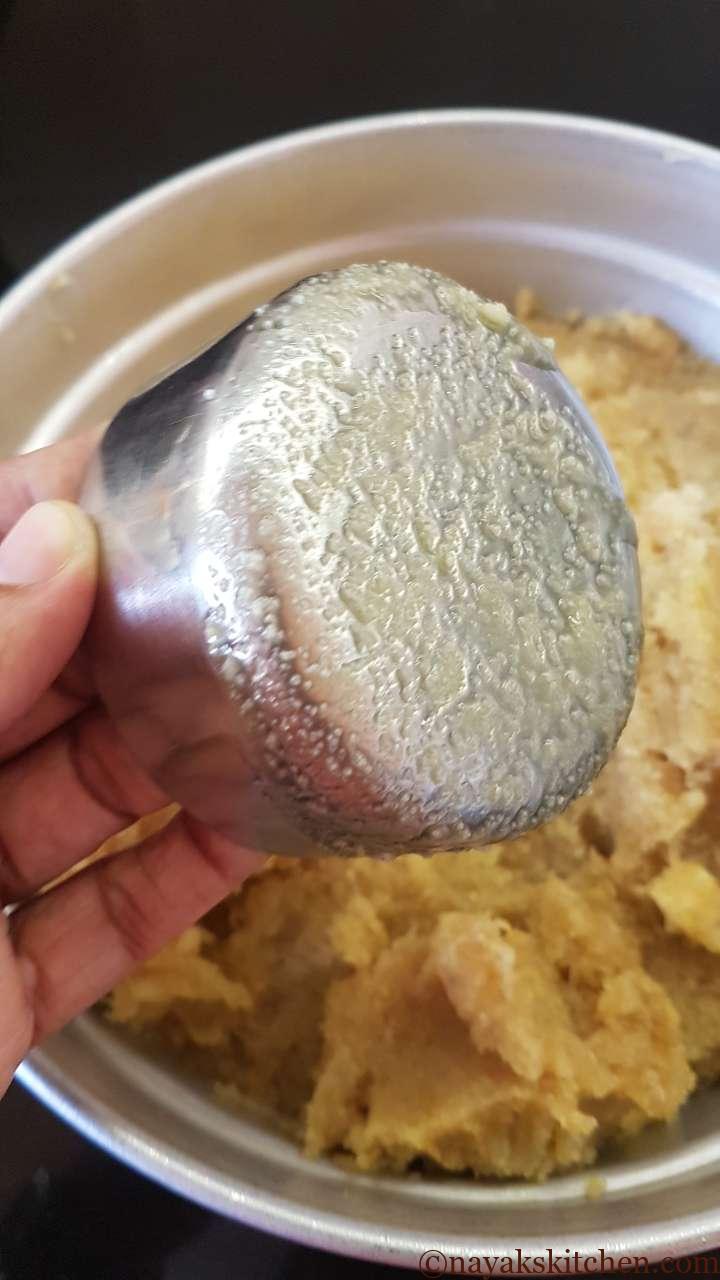
12. Level the mixture using the greased bowl. The surface should look even as shown below.
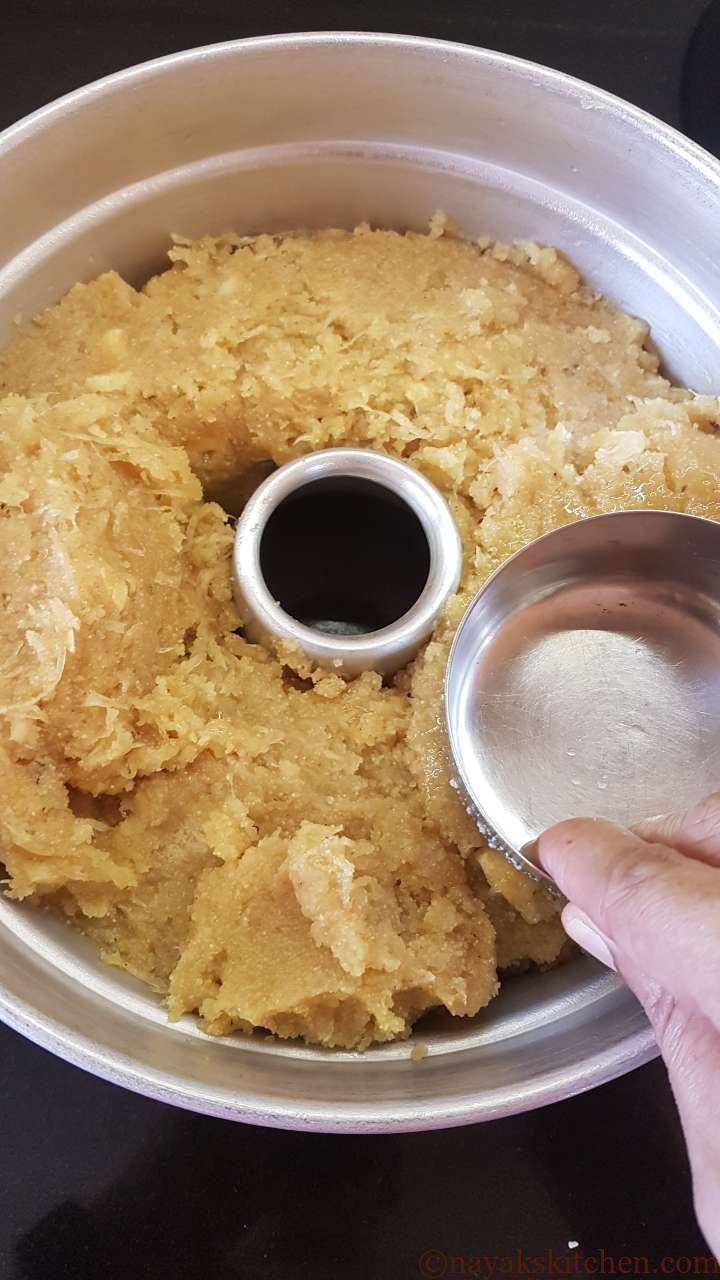
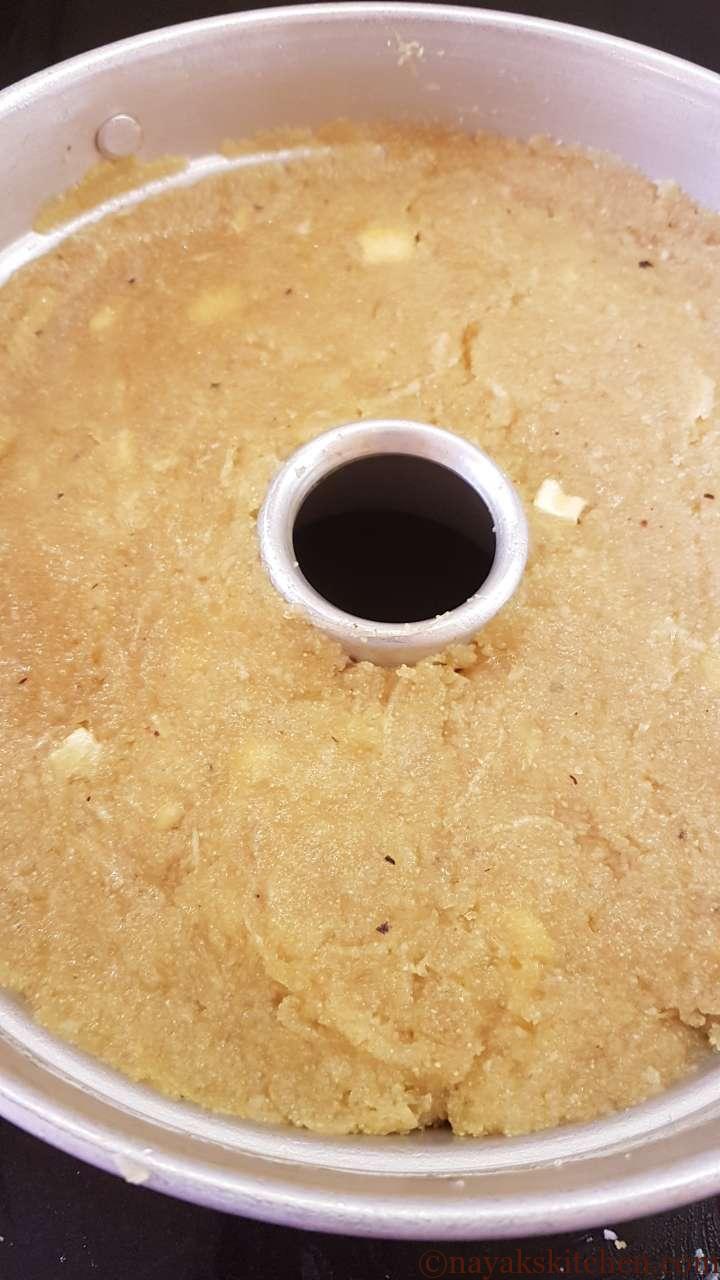
13. Add salt or sand to the cake plate. Place the plate on the gas and subsequently the cake pot over the plate. Switch on the gas. Keep the flame between low-medium. Cook for 40-45 mins or until it is done. (A knife inserted should come clean.) You can drizzle a tablespoon of ghee along the edges of the Tavsali.
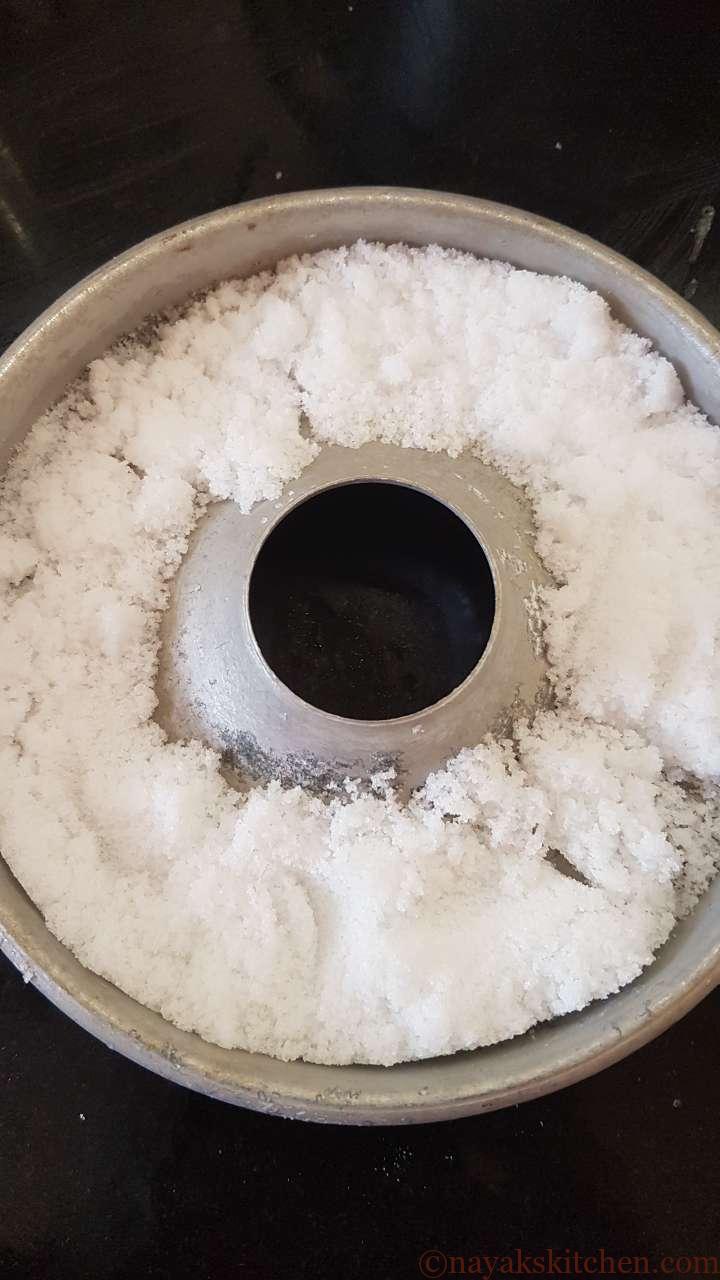
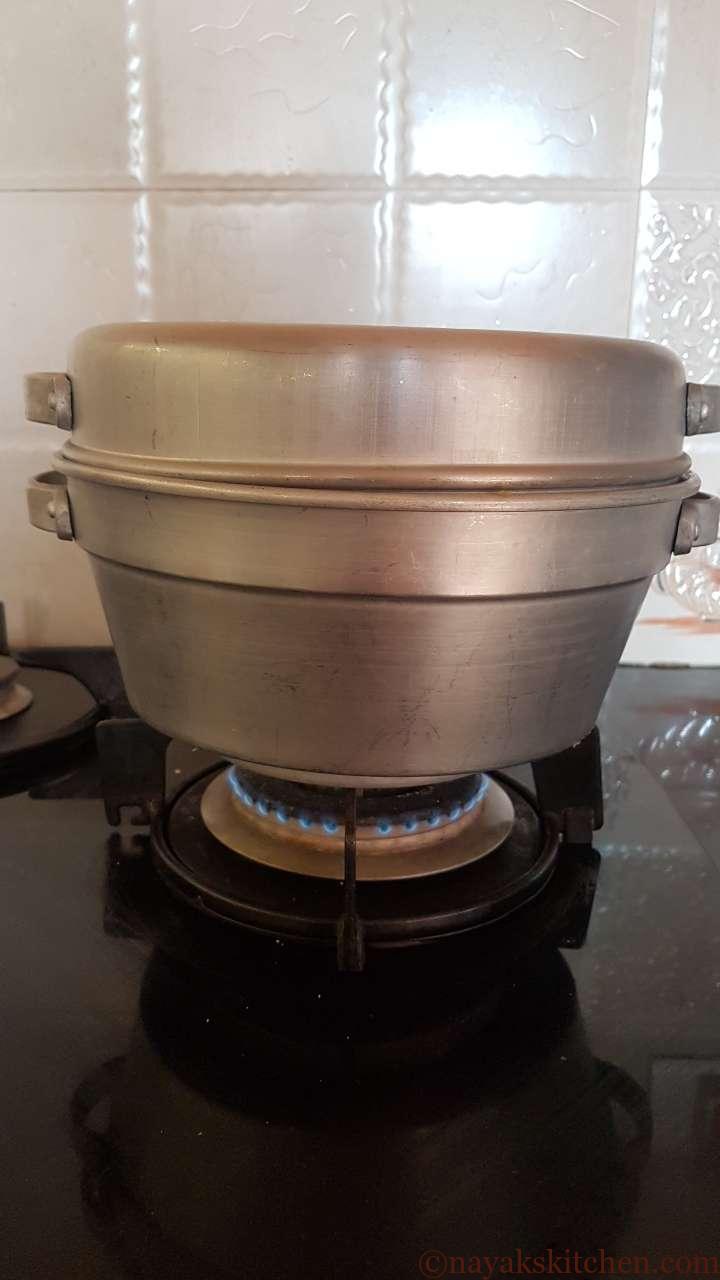
14. Demould the cake only once it is completely cooled. Turn the cake pot upside down over a plate. Cut into desired pieces.
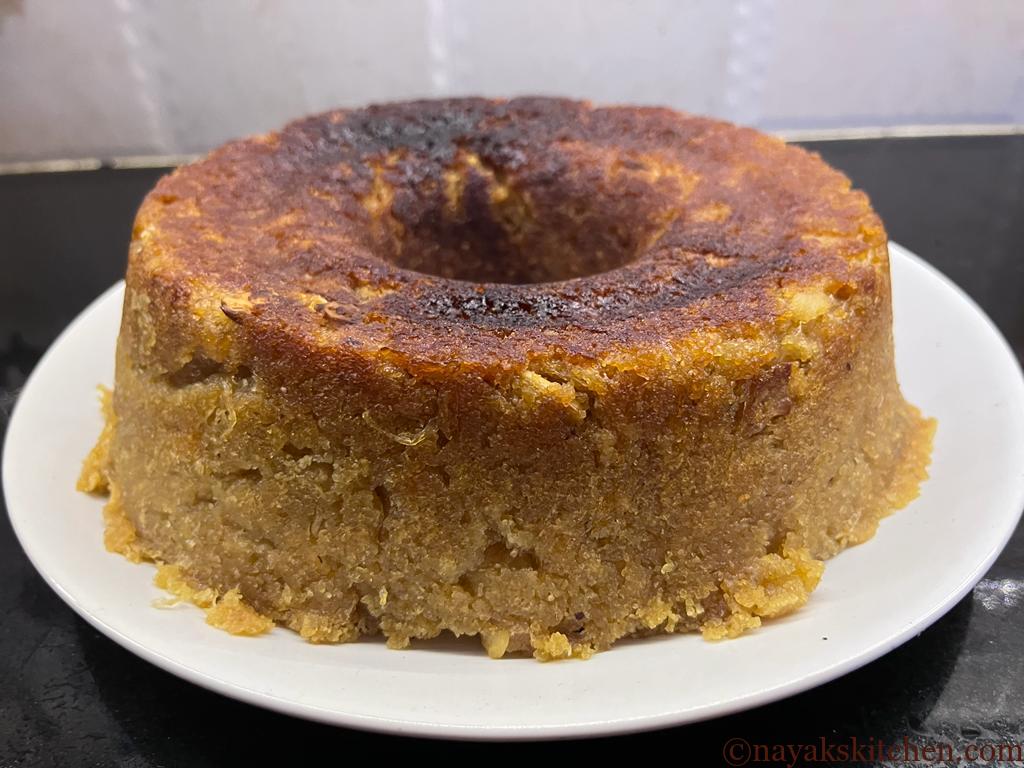
15. Special Note: You can place a turmeric leaf over the levelled tavsali batter. In the picture below, I have baked the cake in a steel deep-bottomed vessel with a thick base. I have placed turmeric leaves on top of the batter. Turmeric leaves impart a heavenly aroma to the tavsali. However, it is optional.
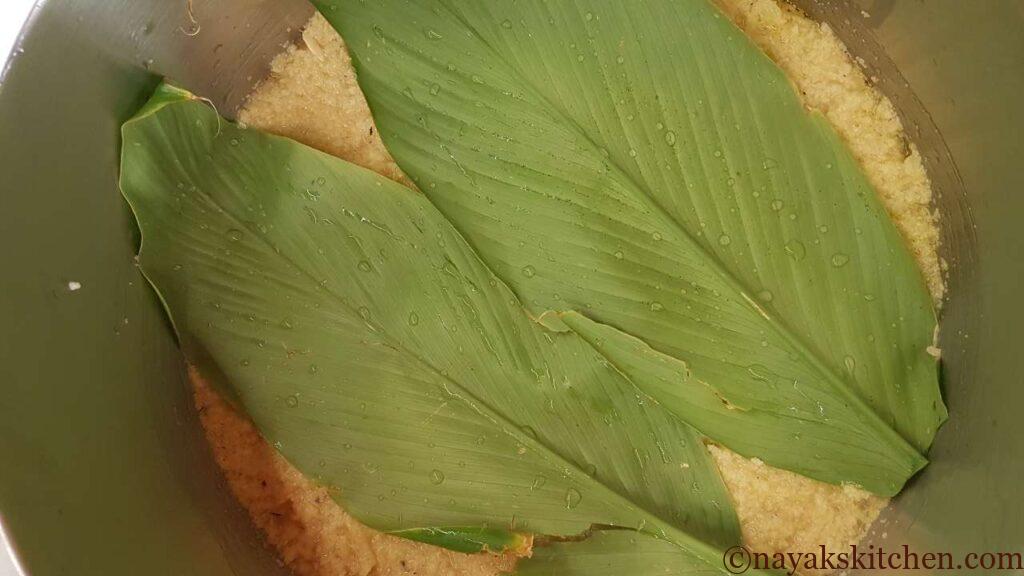
Tavsali | Goan Cucumber Cake | How to make Cucumber Cake?
Course: Indian SweetCuisine: GoanDifficulty: Moderate5
people15
minutes45
minutes1
hourTavsali is a traditional Goan cake recipe using cucumbers that can be served as breakfast, evening snack, or sweet post-lunch.
Ingredients
1 cup = 250 ml
1 tbsp = 15 ml
1 tsp = 5 ml
Grated Cucumber (Tavshe) – 4 cups
Rava (Semolina/Sooji) – 2 and 1/2 cups
Jaggery – 2 cups
Grated Coconut – 2 cups
Cashewnuts – 1/2 cup
Salt – 1/2 tsp
Ghee – 2 tbsp (to roast rava)
Turmeric Leaves – 1-2 nos. (optional)
Directions
- Heat ghee in a kadhai (pan). Roast rava (semolina) until it turns light brown and releases an aroma. Allow it to cool.
- Take the Tavshe and peel it.
- Cut the Tavshe into halves. Then, cut into quarters.
- To remove the seeds, make a slit on its thin skin. Remove the seeds.
- Remove as many seeds as possible since they are very hard. Wash and dry the seeds. You can germinate them to grow tavshi.
- Grate the cucumber. Also, do not throw out its water. Next, add jaggery and grated coconut to the grated cucumber along with its water.
- Further, add salt and mix everything well.
- Add pieces of cashew nuts. Now take this mixture in a deep-bottomed pan or kadhai. On medium flame, allow the jaggery to melt.
- Once the jaggery melts completely, finally add the roasted rava (semolina).
- Keep cooking further till the rava absorbs the water in the mixture. Once this mixture dries up switch off the gas. Also, grease the cake pot or pressure cooker with ghee. (You can also steam or bake in an oven. Refer ‘Methods to cook Tavsali‘ section in the post for more details.)
- Cooking Tavsali
- Next, transfer the cake mixture to the pot. Apply ghee to a small steel bowl (vati).
- Level the mixture using the greased bowl. The surface should look even.
- Place turmeric leaves over the levelled tavsali batter.
- Add salt or sand to the cake plate. Place the plate on the gas and subsequently the cake pot over the plate. Switch on the gas. Keep the flame between low-medium. Cook for 40-45 mins or until it is done. (A knife inserted should come clean.) You can drizzle a tablespoon of ghee along the edges of the Tavsali.
- Demould the cake only once it is completely cooled. Turn the cake pot upside down over a plate. Cut into desired pieces.
Notes
- The seeds of the Tavshe are very firm and hard. Hence, they must be removed. However, if you are using green vegetable cucumbers you can use them along with the seeds if they are very tender.
- When you grate the cucumber it will release a lot of water. Do not throw the water. It has to be used in the recipe. Else your cake will turn out dry.
- Roast the rava well till it releases an aroma and changes to light brown.
- The final batter of Tavsali is thicker as compared to regular cake batters. So do not add water.
- Using turmeric leaves is optional. But it renders a soulful aroma to the tavsali.
- Also, keep checking the cake in between. The sides will turn light brown once done.
- Do not demould when hot. The cake will disintegrate. Allow it to cool completely.
- You can store Tavsali in the fridge for about a week. To reheat, heat a tava/pan and drizzle with a little ghee. Place the pieces on the tava/pan and heat on a very low flame. Turn and fry all sides till golden brown. It tastes really awesome.
- This recipe can be doubled or halved also.




